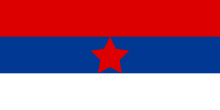Socialist Republic of Serbia
[2][3][4] After the collapse of the Kingdom of Yugoslavia in the April War (1941), the entire country was occupied and partitioned between Axis powers.They had conflicting ideological and political programs, with Chetniks abandoning initial joint resistance efforts alongside Partisans by the end of the Uprising in Serbia, switching instead to extensive collaboration with Axis forces.In order to suppress remaining monarchist opposition, communists initiated the creation of a wider political coalition, thus establishing the People's Front of Yugoslavia (PFY), in August 1945.[15][16] In 1966, one of the most prominent Serbs in the Communist party and also vice-president of Yugoslavia (1963–1966) and founder of Yugoslav intelligence agency OZNA, Aleksandar Ranković was removed from positions due to allegations of spying on SFRY President Josip Broz Tito.Latinka Perović and Marko Nikezić were marked as leaders of this liberal movement inside League of Communists of Serbia.The Federal leadership, led by Tito, believed that the constitutional solution from 1974 could satisfy all the claims of the Socialist Republic of Serbia, but also respect the specifics and special interests of the autonomous provinces.After these events, in 1989 Assembly of Socialist Republic of Serbia voted for constitution amendments that revoked high autonomy for provinces of Vojvodina and Kosovo.After Slovenian authorities forbid a group of Serbs supporting his politics to gather in Ljubljana, Milosević started a trade war with Socialist Republic of Slovenia in late 1989.This Serbian–Slovenian conflict culminated in January 1990 on 14th Congress of the League of Communists of Yugoslavia when Slovenians left the meeting followed by Croatian delegates.The Serbian branch remained relatively stable and loyal to the federal party until the late 1980s, when it became split over what action to take in Kosovo when protests and fights broke out between ethnic Albanians and Serbs.The more traditional Communists supported President Ivan Stambolić, who advocated continued neutrality as a means to solve the dispute; while more radical and nationalist-leaning members supported Slobodan Milosević, who advocated the protection of Kosovo Serbs, who had claimed that their population was being pressured to leave Kosovo by Albanian separatists.In the congress of the Yugoslav League of Communists in 1990, Milosević and his subordinate representatives for Vojvodina, Kosovo and the Socialist Republic of Montenegro attempted to silence opposition from the Socialist Republic of Slovenia who opposed the actions taken against Kosovo Albanian leadership, by blocking all reforms proposed by the Slovene representatives.In 1974, new Constitution of Serbia was adopted, and collective state presidency was formed, not as a committee of the Assembly, but as a supreme governing body.




Serbo-CroatianEmblemYugoslaviaBelgradeSerbianHungarianAlbanianGovernmentMarxist–Leninistone-partysocialist republicTitoistDominant-partyparliamentary republicHead of stateSiniša StankovićSlobodan MiloševićHead of governmentBlagoje NeškovićStanko RadmilovićNational AssemblyCold WarWorld War IIEnd of World War IILast Constitution adoptedFederal Republic of YugoslaviaISO 3166 codeTerritory of the Military Commander in SerbiaKingdom of HungaryIndependent State of CroatiaKingdom of BulgariaRepublic of SerbiaSerbiaKosovoconstituent republicsSocialist Federal Republic of Yugoslaviafederated republicHistory of SerbiaAxis occupation of SerbiaKingdom of YugoslaviaApril WarAxis powersNazi GermanyMetohijaFascist ItalyItalian AlbaniaBačkaHungarySyrmiaBulgariaChetniksPartisansUprising in SerbiaMain National Liberation Committee for SerbiaUžiceRepublic of UžiceRed ArmyAnti-fascist Assembly for the People's Liberation of SerbiaSerbo-Croatian Cyrillicfederated stateDemocratic Federal YugoslaviaPeople's Assembly of SerbiaPeople's Government of SerbiaAutonomous Province of VojvodinaAutonomous Region of Kosovo and Metohijarepublicfirst ConstitutionConstitutional AssemblyCommunist Party of SerbiaCommunist Party of YugoslaviamonarchistPeople's Front of YugoslaviaAleksandar RankovićYugoslav ConstitutionJosip Broz Titothe Croatian SpringLatinka PerovićMarko NikezićPresident of the Presidency of Socialist Republic of SerbiaDragoslav MarkovićEdvard Kardeljnationalismmajor protests erupted in KosovoSerbs of KosovoParaćinParaćin massacrePresident of SerbiaIvan Stambolić8th SessionPetar Gračaninround of coups in the Communist party leadershipAntibureucratic revolutioncommunistSR SloveniaSR CroatiaLeague of Communists of Yugoslaviabreakup of YugoslaviaYugoslav People's ArmySocialist Republic of Slovenia14th Congress of the League of Communists of YugoslaviaSerbia and MontenegroMontenegroSocialist Autonomous Province of VojvodinaSocialist Autonomous Province of KosovoSerbia properRomaniaAlbaniaSR MacedoniaSRs Montenegro, Bosnia and Herzegovinaand CroatiaEthnic groups in SerbiaAlbaniansHungariansCroatsethnic Muslimsethnic YugoslavsSlovaksRomaniansBulgariansRomaniMacedoniansRusynsSlovenesVlachsYugoslavs